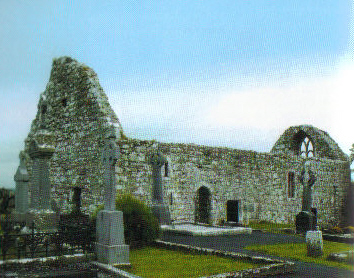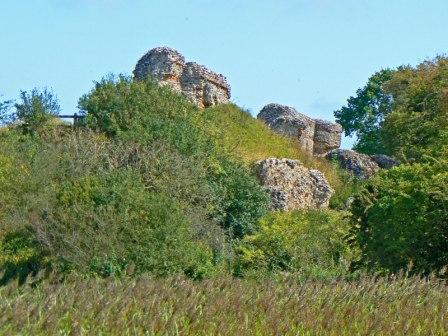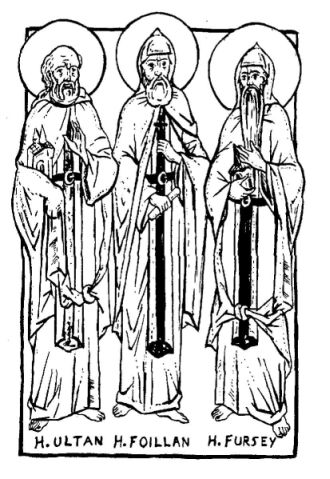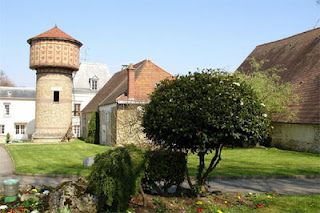January 16 is the feast of Saint Fursa (Fursey), a saint
famous not only for his missionary labours in England and
France but also for his visions of the afterlife. Dr William
Reeves, the 19th-century Anglican bishop who translated
Adamnan's Life of Columba said of Saint Fursa:
"Among
the Irish saints, who are but slightly
commemorated at home, yet whose praise is in all the
churches, St. Fursa holds a conspicuous place. With
Venerable Bede as a guarantee of his extraction, piety, and
labours, and above a dozen different memoirs, of various
ages, which were found on the Continent in Colgan's time,
the history of this saint is established on the firmest
basis."
I would need to do a lot more research into all of these
areas of Saint Fursa's life to really do him justice, but
for now, here is a summary of his life by another Irish
Anglican writer, the Reverend Thomas Olden:
FURSA, SAINT (d. 650), of Peronne in France, was an Irishman
of noble birth. Two pedigrees of him are given in the 'Book
of Leinster,' and also in the 'Lebor Brecc’.
One traces his descent from Rudraidhe Macitri, ancestor of
the Clanna Rudraidhe, of the race of Ir; the other from
Lugaidh Laga, brother of Olioll Olum of the race of Heber;
but they evidently refer to different perons, and Colgan has
shown that there were two saints named Fursa, the first of
whom flourished about 550. The 'Martyrology of Donegal,' as
well as the 'Lebor Brecc' notes to the 'Calendar of Oengus,'
clearly regards the first pedigree as that of Fursa of
Peronne, but Colgan with Keating regards the Fursa of the
second as the saint of Peronne, and this is clearly right,
as Sigebert, king of East Anglia, received him in 637. His
father was Fintan, son of Finlogh, a chieftain of South
Munster; his mother, Gelges, was daughter of Aedh Finn of
the Hui Briuin of Connaught. He was probably born somewhere
among the Hui Briuin, and baptised by St. Brendan. His
parents having returned to Munster, the child was brought up
there, and from his boyhood he 'gave his attention to the
reading of the Holy Scriptures and monastic discipline.' He
retired to study in the island of Inisquin in Lough Corrib,
under the abbot St. Meldanr called his ' soul-friend.' He
afterwards built a monastery for himself at a place called
Rathmat, which appears to be Killursa (Fursa's Church), in
the north-west of the county of Clare (photo of ruins
below).

After this he set out for Munster to visit his relatives.
After his arrival he had the first of several remarkable
cataleptic seizures, during which he had visions of bright
angels, who raised him on their wings, and soothed him by
hymns. In one trance famine and plagues were foretold. This
evidently refers to the second visitation of the plague
known as the Buidhe Connaill, 'the yellow or straw coloured
plague,' which visited Ireland about fourteen years after
Fursa's death. The chief visions appear to have taken place
in 627. Deeply impressed by them, Fursa travelled through
Ireland, proclaiming what he had heard. At Cork he had a
vision of a golden ladder set up at the tomb of St. Finn
Barr [q.v.] and reaching to heaven, by which souls were
ascending.
For ten years, in accordance with angelic directions, he
continued 'to preach the word of God without respect of
persons.' In the notes on the 'Calendar of Oengus’ a strange
story is told of his exchanging diseases with St. Maignen of
Kilmainham. To avoid admiring crowds and jealousy, Fursa
went away with a few brethren to a small island in the sea,
and shortly after, with his brothers Foillan and Ultan, he
passed through Britain (Wales), and arrived at East Anglia,
where he was hospitably received by King Sigebert.
The Venerable Bede records the Saint's arrival, in his
works:
Whilst Sigbert still governed the kingdom, there came
out of Ireland a holy man called Fursa. renowned
both for his words and actions, and remarkable for
singular virtues, being desirous to live as a stranger
and pilgrim for the Lord's sake, wherever an opportunity
should otter. On coming into the province of the East
Angles, he was honorably received by the aforesaid king,
and performing his wonted task of preaching the Gospel,
by the example of his virtue and the influence of his
words, converted many unbelievers to Christ, and
confirmed in the faith and love of Christ those that
already believed. Here he fell into some infirmity of
body, and was thought worthy to see a vision of angels;
in which he was admonished diligently to persevere in
the ministry of the Word which he had undertaken, and
indefatigably to apply himself to his usual watching and
prayers; inasmuch as his end was certain, but the hour
thereof uncertain, according to the saying of our Lord,
"Watch therefore, for ye know neither the day nor the
hour. " Being confirmed by this vision, he set himself
with all speed to build a monastery on the ground which
had been given him by King Sigbert, and to establish a
rule of life therein. This monastery was pleasantly
situated in the woods, near the sea; it was built within
the area of a fort, which in the English language is
called Cnobheresburg, that is, Cnobhere's Town;
afterwards, Anna, king of that province, and certain of
the nobles, embellished it with more stately buildings
and with gifts. This man was of noble Scottish blood,
but much more noble in mind than in birth. From his
boyish years, he had earnestly applied himself to
reading sacred books and observing monastic discipline,
and, as is most fitting for holy men, he carefully
practiced all that he learned to be right. Now, in
course of time he himself built a monastery, wherein he
might with more freedom devote himself to his heavenly
studies.
After another vision - twelve years since his last seizure -
he hastened to build the monastery Cnoberesburg or
Burghcastle, in Suffolk, on land granted by the king. Then,
committing it to the charge of Goban and Dichull, he went
away to his brother Ultan, with whom he lived as a hermit
for a year.
Owing to the disturbed state of the country he had to go to
France and take refuge with Clovis, king of Neustria. The
king being a child, the government was in the hands of
Erchinoald, mayor of the palace, who gave him land at
Latiniacum, now Lagny, on the Marne, six leagues from Paris.
Here he erected a monastery in 644. According to the account
in the ' Codex Salmanticensis,' it was when travelling- with
Clovis and Erchinoald that his last illness came on. He died
on 16 Jan. probably in 650, at Macerias, now Mazeroeles. He
was buried at Peronne, in the church built by Erchinoald,
and with this place his name has since been associated. He
was reputed to have performed miracles in his life-time, and
even his pastoral staff, if sent to a sick person, was
supposed to have a healing power. The brethren whom he took
with him formed the nucleus of an Irish monastery, and the
succession appears to have been kept up by emissaries from
Ireland, as we read in the 'Annals of the Four Masters' at
774, that 'Moenan, son of Cormac, abbot of Cathair Fursa
(the city of Fursa, i.e. Peronne) in France, died.'
Fursa's visions were placed on record soon after his death
in 'the little book' to which Baeda refers, and which
Mabillon considers to be the life published by Surius at 16
Jan. Baeda describes the agitation of a monk who, when
describing what he heard from Fursa's lips, though it was
the severest season of the year, and he was thinly clad,
broke out into a profuse perspiration from mere terror.
[Codex Salmanticensis, p. 77 (London, 1883); Bedae Eccl.
Hist. lib. iii. cap. 19; Lanigan's Eccl. Hist. ii. 448-64;
Annals of the Four Masters, A.D. 774 ; Calendar of Oengus,
p. xxxv; Dr. Todd's St. Patrick, p. 406.] T. 0.
L. Stephen, ed., Dictionary of National Biography, Vol. XX
(1889), 333-334.
============================
-
Died 648 at
Mezerolles, France
-
buried at Peronne,
Picardy, France
-
when his relics were
translated in 654,
his body was found incorrupt
-
relics re-translated
in 1056
-
relics re-translated
in 1256
-
miracles reported
at his tomb
-
most relics destroyed
in the French
Revolution
Troparion of Saint Fursey of Burgh Castle tone 5
Establishing thy monastery in a Roman fortress
thou didst teach men that the Orthodox Faith is a
true bastion
against the onslaughts of every evil force, O Father
Fursey.
Wherefore pray to God for us
that we may all be bastions of the Faith
standing firm against the rising tide of falsehood,
that our souls may be saved.
Kontakion of Saint Fursey tone 4
Thou didst need the walls of stone
to defend the Faith against its pagan enemies, O
Father Fursey,
but pray for us that we may have a spiritual wall
around us
to defend the Faith against its enemies.
Following thee and praising thy eternal memory,
we stand firm against every error, ever singing:
Rejoice, beloved of God, our Father Fursey.
=================================================
An abridged biography of the
Saint
Source:
http://www.bartleby.com/210/1/164.html
Son of
Fintan, king of part of Ireland, he was abbot first of a
monastery in his own country, in the diocese of Tuam, near
the lake of Orbsen, where now stands the church of Kill-fursa,
says Colgan.
Afterwards travelling with two of his brothers, St. Foilan
and St. Ultan, through England, he founded, by the
liberality of king Sigibert, the abbey of Cnobbersburg, now
Burg-castle in Suffolk (photo of ruins below).

Saint Ultan retired into a desert, and St. Fursey, after
some time, followed him thither, leaving the government of
his monastery to St. Foilan.

Being driven thence by the irruptions of king Penda, he went
into France, and, by the munificence of king Clovis II. and
Erconwald, the pious mayor of his palace, built the great
monastery of Latiniac, or Lagny, six leagues from Paris, on
the Marne (current photo of monastery, below).

He was deputed by the bishop of Paris to govern that diocese
in quality of his vicar: on which account some have styled
him bishop. He died in 650 at Froheins, that is,
Fursei-domus, in the diocese of Amiens, whilst he was
building another monastery at Peronne, to which church
Erconwald removed his body.
His relics have been famous for miracles, and are still
preserved in the great church at Peronne, which was founded
by Erconwald to be served by a certain number of priests,
and made a royal collegiate church of canons by Lewis XI.
Saint Fursey is honoured as patron of that town. See his
ancient life in Bollandus, from which Bede extracted an
account of his visions in a sickness in Ireland,
l. 3. hist. c. 19. See also his life by Bede in MS. in the
king’s library at the British Musæum, and Colgan, Jan. 16.
p. 75. and Feb. 9. p. 282.
|